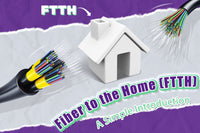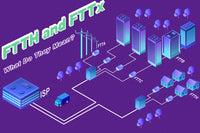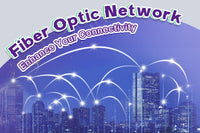Contents
To cater to the growing demand for video conferences and streaming, the internet has transformed dramatically over the years. In the past, a computer could only connect to the internet through a network cable. Today, wireless internet allows people to take out their devices like phones or laptops anywhere with ease. As technology goes on, broadband internet has evolved to fiber internet and 5G has gained widespread attention in latest years. But what is the difference between these two technologies? Do you know their pros and cons? When to choose them? You’ll find the answer in the following content.
What is 5G?
5G, the fifth generation of cellular networks, represents a giant leap forward from its predecessors-1G, 2G, 3G, and 4G. As is known to all, the peak speed of 4G is only 1 Gbps, but 5G can achieve a speed of up to 20 Gbps theoretically. Offering significantly faster speeds than 4G, 5G is designed to perform well in the fields of the Internet of Things (IoT), artificial intelligence (AI), and automation. Beyond enhancing person-to-person communications, 5G is revolutionizing the way people interact with different smart devices and internet things.

How Does 5G Internet Work?
It is known that a typical mobile network usually contains two main components: the Radio Access Network (RAN) and the Core Network. 4G technology operates through mobile towers, while 5G technology typically relies on small cells at the new mmWave frequencies. 5G technology adopts the format of Orthogonal Frequency Division Multiplexing (OFDM), which can encode high-band airwaves that are incompatible with 4G and offer low latency for users. The 5G also uses Massive MIMO (multiple input, multiple output) technology, enabling multiple transmitters and receivers to transmit data at the same time so that more people can simultaneously connect to the network.
The core networks help handle all data and internet connections. 5G technology relies more on software rather than hardware. Improvement in cloud-based technologies and IT process automation can significantly enhance 5G technology. Furthermore, 5G networks also have functions of virtualization and network slicing.
What is Fiber Optic Internet?
Fiber broadband is a type of internet connection that uses fiber optic cables to carry data signals. Unlike traditional coaxial and copper cables, fiber optic cables are highly resistant to interference over long distances and offer high speed and reliable connectivity. This makes fiber broadband well-suited for bandwidth-intensive applications like video conferences and data centers. In contrast to cable, satellite, and Digital Subscriber Line (DSL) internet, fiber internet outperforms in terms of signal transmission speed, capacity, and stability.
How Does Fiber Optic Internet Work?
Fiber optic internet relies on fiber optic cables made of strands of optical fibers to transmit data via light pulses. The core and the cladding of the fiber play an important role in keeping the light signal inside the cable and preventing signal loss in this process. At the end of the transmission, the receiver will capture optical signals and convert them to electrical signals.
One challenge in fiber optic internet deployment is the last mile--the final part of the fiber network that connects homes or buildings to the fiber infrastructure. Fiber to the Home (FTTH) and Fiber to the Building (FTTB) extend fiber optic cables directly to individual residences.
5G vs. Fiber: What are the Differences?
- Installation and Setup: 5G is a type of wireless technology that sends and receives wireless internet signals through low-, mid-, and high-frequency airwaves. The installation only requires a compatible device and a 5G signal. Fiber, in contrast, transmits light signals by bundles of glass fibers directly to homes or local nodes. Fiber internet requires the installation of physical cables, which can be more time-consuming.
- Speeds: Though 5G is designed to provide a rapid signal transmission, it still lags behind fiber internet in terms of speed. 5G can achieve a download speed of 1 Gbps but has a lower upload speed. 5G speed depends on the frequency band used and may be impacted by other factors like distance from cellular towers and 5G network planning. In contrast, fiber has a superior download and upload speed. With symmetrical speeds, fiber ensures the same download and upload, making it a reliable choice for bandwidth-intensive activities.
- Latency: Though 5G can suffice daily use like web surfing, video watching, and app use, its higher latency may make it not suitable for high-demanding activities like online gaming or video chat. Fiber internet has a lower latency of about 1 millisecond, making it more suitable for applications that require fast response times, such as online gaming and stock trading.
- Reliability: Fiber has superior reliability and security than 5G due to its resistance to interference, including Electromagnetic Interference (EMI), Radio Frequency Interference (RFI), as well as some network security threats. 5G signal strength is more susceptible to physical obstacles, and environmental factors like rain, wind, and temperature fluctuations.
- Coverage: Fiber coverage is widespread in many urban areas but can be limited in some rural areas. 5G Internet is still being deployed, so it is still mainly available in densely populated areas and is also not available in many rural areas or remote areas.
- Cost: For consumers, the cost of 5G and fiber internet depends on different ISPs and service plans. But in general, a subscription to fiber internet can be less expensive than 5G as it can be used by multiple families. For providers, fiber internet can be more cost-effective in the long run.
Should I Choose 5G or Fiber?
The choice between 5G and fiber depends on your specific requirements and usage scenarios. If you are looking for ultra-fast and stable speed for your online gaming, video conferencing, and large file download, fiber will be the first choice. Fiber internet is more cost-effective for those heavy users or businesses.
5G may offer slow network speed in network peak time or be impacted by obstacles in your home or office. But in terms of mobility and flexibility, it is definitely the winner. If you need internet access on the go on your smartphones, laptops, and other mobile device outside of Wi-Fi zones, whether in the street, on the bus, or in the park, 5G is the ideal choice.
Conclusion
Though 5G and fiber are different technologies, both can offer significant advantages to enhance the connectivity between the internet and our modern lives. In fact, fiber and 5G will complement one another rather than compete in the digital world.
FAQs
Is 5G faster than fiber?
No, fiber has a much higher speed than 5G max speed.
Will 5G home internet replace fiber to the home internet?
No, though 5G is more flexible than fiber internet, the latter has a higher speed, higher bandwidth, and added reliability.
Is 5G or fiber better for gaming?
For casual or mobile gaming, 5G can be a better option, especially if you want flexibility. But if you are a heavy gamer, fiber is a better choice thanks to its low latency and reliability.
For more information on this topic, you can keep up on our blogs. While VCELINK offers general and basic information for our customers and other visitors to the website, it’s not professional advice.



Be the first one to comment.
Leave a comment